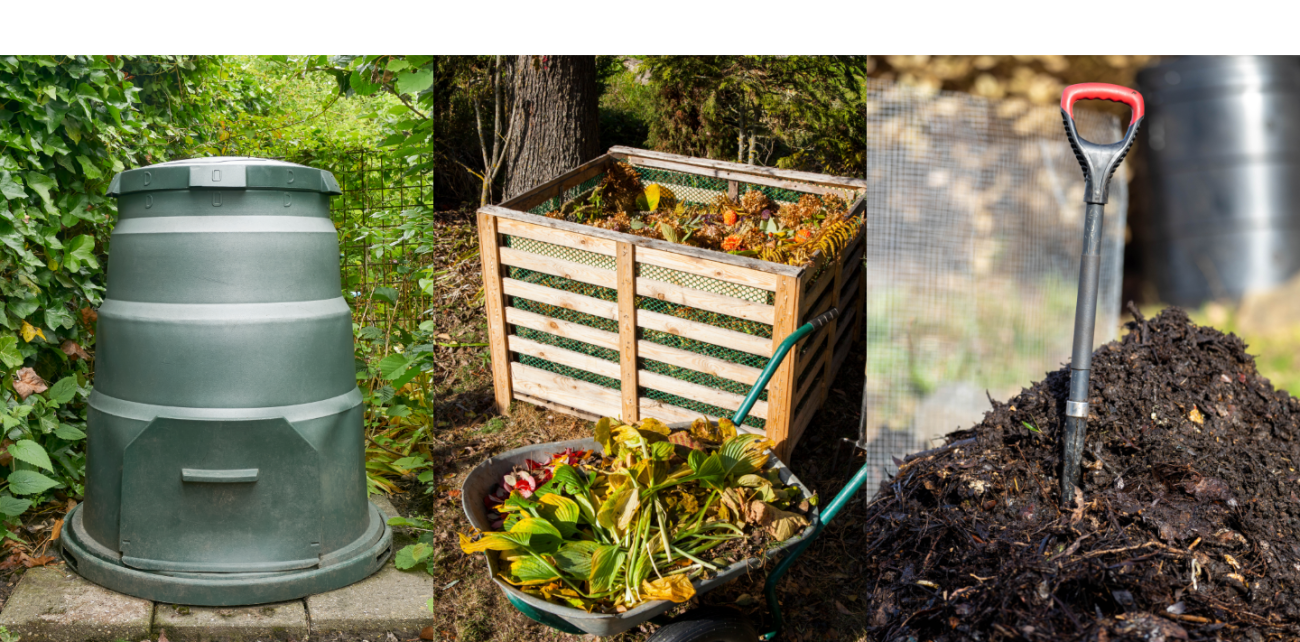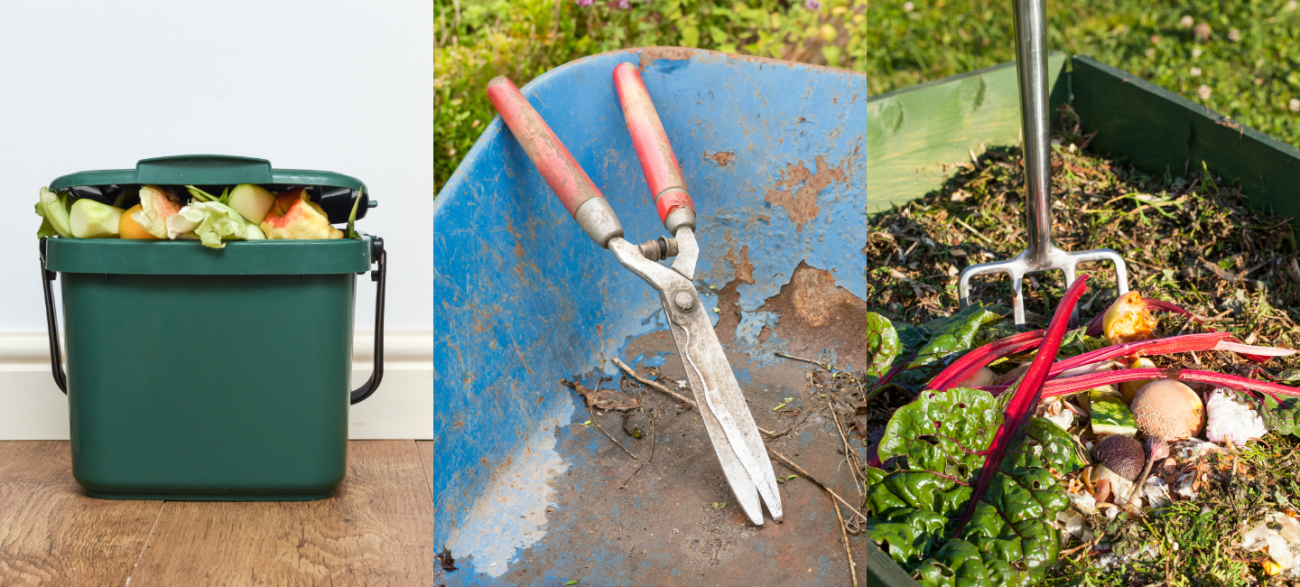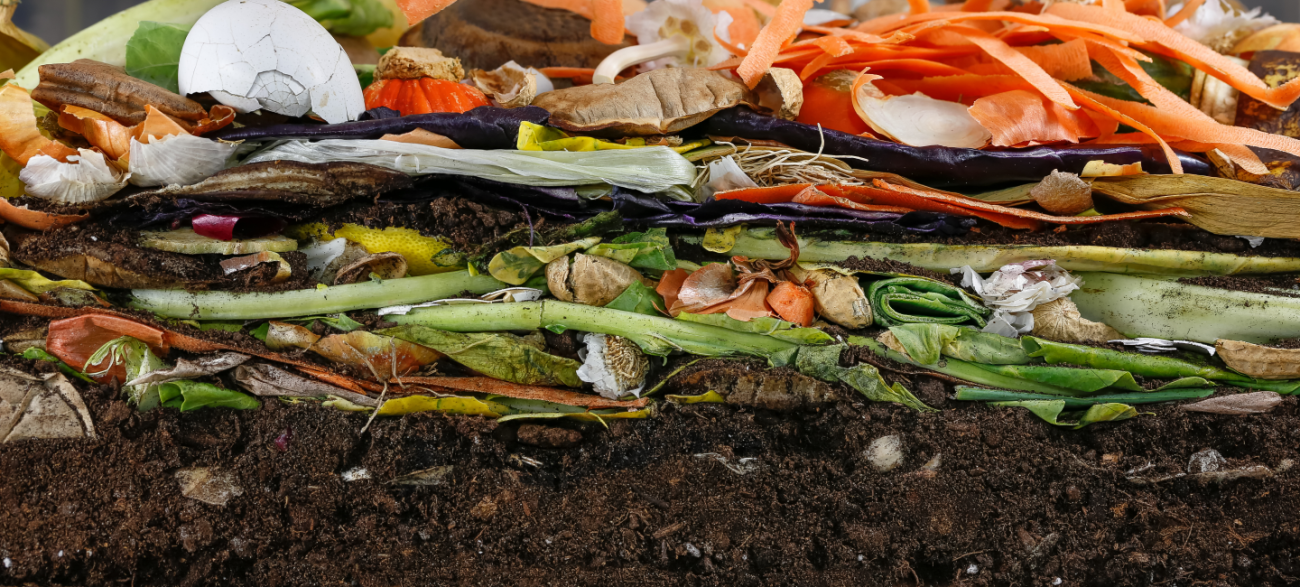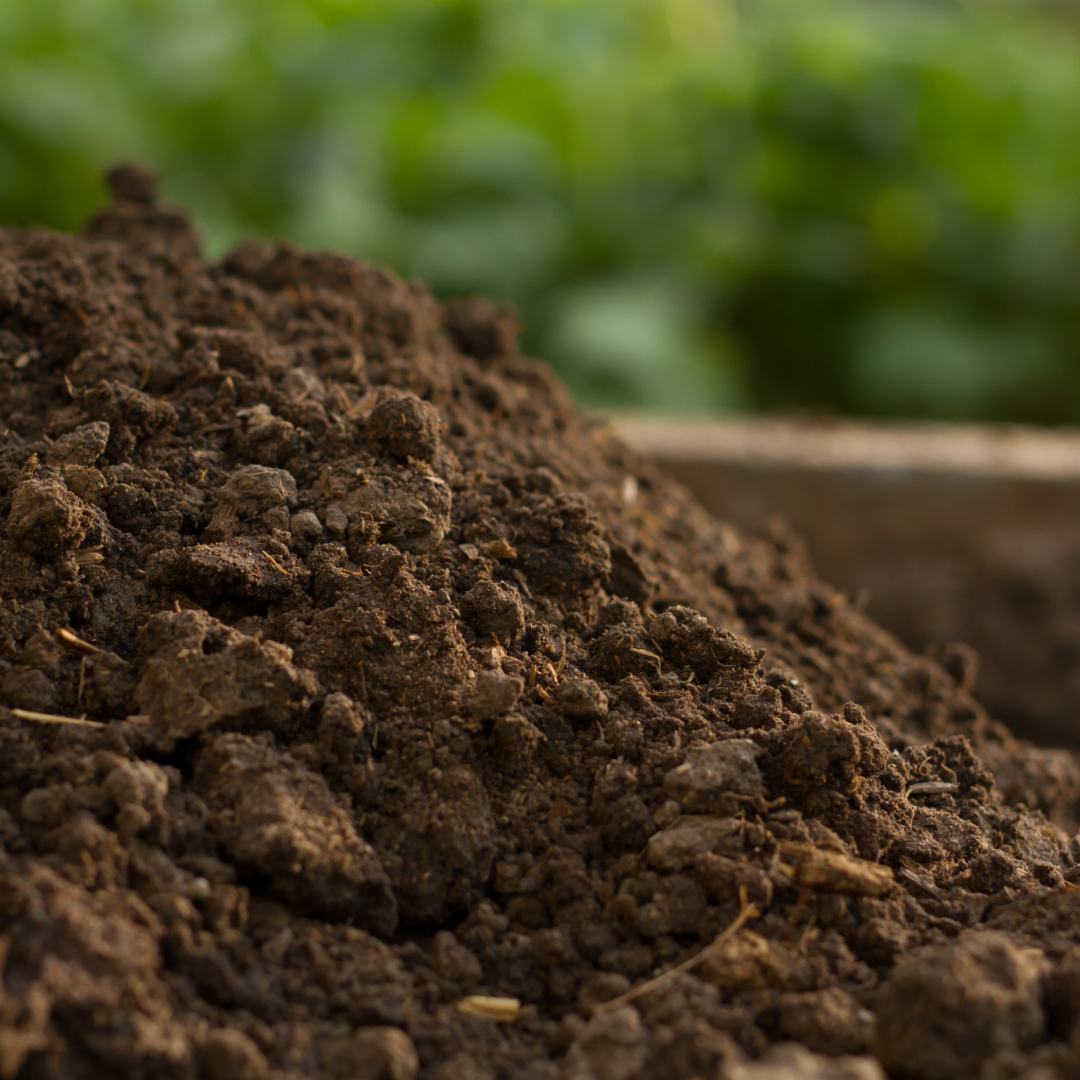
What is Composting?
Composting converts organic waste materials into a nutrient-rich, soil amendment by bringing together the right ingredients in the right amounts to speed up the natural decomposition process. To put it simply, decomposition is nature’s way of recycling nutrients. By turning our food scraps and yard waste into compost, we can transform over one-third of our waste into a useful product. In Wake County, over 34% of household trash could be composted. What’s more, composting is an entirely scalable activity, and can be done on both a small scale in your own backyard or on a large scale at an industrial composting facility.
Why Compost?

Making compost and adding it to your garden will:
- Reduce the need to buy plant food and our reliance on artificial fertilizers.
- Help plants grow bigger and healthier.
- Help plants suppress plant diseases and pests naturally, reducing the need for chemical pesticides.
- Help soil retain moisture and save money and time on watering.
- Enrich soil, improving its structure, making it easier to dig and prevent erosion.
- Reduce the amount of trash your household generates and sends to landfill.
- Reduce emissions from municipal landfills and lower your carbon footprint.
- Serve as a useful educational tool to teach children about natural resource conservation.
Backyard Composting: Getting Started
Backyard composting is an easy and cost-effective way to create your own plant food in your own yard. Many gardeners agree that a backyard compost system is an important part of a healthy garden. There are three main types of backyard compost systems:

What Type of Compost System is Right for Me?
Manufactured Compost Bin
A manufactured compost bin is a good starting point, with features that allow for greater control over the process of composting and decomposition, which is especially important if you are trying backyard composting for the first time or for those composting in an urban setting. They are contained systems that take up less space and are designed to be pest resistant. There are many different types of manufactured compost bins available at retail. Things to look for in a good, manufactured compost bin include:
- Made from a durable material to withstand weathering.
- Sufficient ventilation holes to allow air to flow through the bin.
- A tight-fitting lid to prevent drying out and pests gaining access.
- A conical shape to prevent compost getting stuck in corners.
- A harvest door for compost removal.
Drawbacks of a manufactured compost bin include:
- The initial cost of buying the bin.
- Expect to pay anywhere between $50-$300 for a compost bin.
- The amount of compost you can produce is limited to the size of the bin.
Do-It-Yourself (DIY), Homemade Compost Bin
A Do-It-Yourself (DIY), homemade compost bin is usually a less expensive alternative to a manufactured bin and can often yield more results because you can determine the size you need yourself. You will need an area between 3 cubic feet (to reach volume and desired temperatures in the middle) and 5 cubic feet (to keep the amount of mixing manageable).
Common materials used to construct DIY compost bins include trashcans, drums, concrete blocks, wooden pallets, hardware cloth, etc. There are hundreds of DIY compost bin design ideas on Pinterest. Search for one that will work best for you.
Drawbacks to DIY compost bins include:
- Some designs fail to consider the right amount of ventilation needed to achieve the optimum rate of decomposition.
- Composting is an aerobic process.
- Oxygen is one of the four main ingredients required in composting.
- Not enough ventilation can turn your pile anaerobic, but too much ventilation can prevent your pile from reaching temperature in the center.
Open Pile
An open pile is the least expensive option and typically yields the most compost due to their lack of constraints (walls). You will need more space for an open pile, preferably an area between 4-5 cubic feet. Compost piles larger than 5 cubic feet tend to become unmanageable and difficult to turn. Open compost piles are better suited in areas from neighboring properties.
Drawbacks to open piles include:
- They can attract local wildlife.
- They tend to lose moisture quickly in summer.
- Their lack of walls provides a large surface area for moisture to evaporate.
You will often see open compost piles with a tarp over the top in summer to keep the moisture in and the deer out!

Where to Locate a Backyard Compost System?
After selecting the type of compost system to use in your backyard, you need to decide where to place it. The ordinance for Wake County states, “Composting activity shall not occur within 25 feet of any structure or used dwelling which is located on adjacent property.” This means your compost bin should remain 25 feet or more from your neighbor’s house or shed. If you live within a municipality of Wake County, you will need to check your town’s ordinance on residential backyard composting. Learn more about the ordinance in Wake County here.
In addition, there are a few things to consider when deciding where to situate your compost bin or open pile:
On Bare Ground
Active compost systems produce moisture, and the moisture will drain, so it needs to be installed over a permeable surface, such as soil, grass or mulch. Compost systems that drain into the ground also provide access for decomposers to enter and leave the system freely (as conditions fluctuate with seasonal variances). Decomposers (including bacteria, fungi, protozoa and insects) are one of four key ingredients required in composting.
Close By
Make throwing food scraps into your compost system convenient. Common mistakes include placing compost systems ‘out of sight’, at the end of the yard because they are not aesthetic, but this can quickly become ‘out of mind’ and people stop using them because they either forget about them or they are not as conveniently located compared to the trashcan.
- Tip: Place your compost bin near your trashcan to make walking to it just as convenient.
Away from Structures
Structures susceptible to rot should not be in contact with decomposing materials, so do not put your system up against a wooden fence or storage building.
Proximity to Water
Your system should be within reach of a water source, a garden hose or watering can to maintain the right moisture level. If a compost system dries out, it will cease to break down and remain dormant. Water is one of the four key ingredients in composting. A properly maintained compost system should be moist at all times, like a wrung-out sponge, but never soggy. Too much water and the decomposers will die.
- Tip: Fill your kitchen pail up with water before emptying it into the composter outside and you can feed and water and your compost system in one visit!
Partial Shade
This helps to prevent excessive heat build-up, especially in plastic bins in warmer climates. If shade is not an option for you, pay closer attention to the moisture levels in your compost system, especially in summer.
Organic Materials Suitable for Backyard Composting
2 x Browns/Carbon (C) |
1 x Greens/Nitrogen (N) |

|
Dry leaves (not black walnut trees) |
Fruits and vegetable scraps |
|
Twigs and plant stalks |
Shrub, bush and plant clippings |
|
Cardboard tubes and paper towels |
Houseplant leaves |
|
Straw (not hay) |
Grass clippings (in moderation) |
|
Shredded paper or newspaper (non-glossy) |
Coffee grounds and filters |
|
Paper napkins and paper towels |
Tea leaves |
|
Pizza boxes |
Flowers and dead blossoms |
|
Paper pulp egg cartons and drink trays |
Freezer-burned fruits and vegetables |
|
Untreated sawdust, bark or wood chips |
Old, expired herbs |
|
Nut shells (not walnut, and in moderation) |
Hair, pet fur and feathers |
|
Cotton balls/pads |
Beer hops and wine-making dregs |
|
Dryer lint (natural fibers) |
Aquarium or pond algae and plants |
|
Natural fibers (cotton, wool, linen, burlap and hemp) |
Seaweed |
|
Brown paper bags |
Herbivorous animal manure (rabbits, chickens, horses) |
|
Pencil shavings |
Drink dregs, coffee, tea, soda and juice |
|
Paper baking cups |
Weeds before they go to seed |
|
Bamboo skewers and toothpicks |
|
|
Herbivorous pet bedding (rabbits, chickens, etc.) |
|
Do I Need Any Tools or Equipment?
Now that you have selected the type of backyard composting system you want and where to place it, it’s time to get composting. While you do not need to go out and buy garden tools, there are some inexpensive hand tools and supplies that can take the ‘work’ out of composting:
- A kitchen pail with a tight-fitting lid to collect food scraps in.
- A handheld garden fork for burying food scraps.
- A pair of handheld hedge trimmers or pruners for chopping larger materials.
- A garden hose or watering can to keep the pile moist.
- A pitchfork or compost aerator for aerating the pile.
- A spade to remove finished compost.

What is the Method for Composting?
There are two main styles or methods to backyard composting. There is the ‘hot’ or batch style method and the ‘cold’ or continuous style method. The ‘cold’/continuous style of composting allows you to dump it as you produce it and then move on with your day, but as with all things convenient, there is a drawback. The decomposition process takes slightly longer, about 3-12 months. Most people who compost at home use the ‘cold’ composting method.
However, if you need your compost fast and have a little more time to invest, using the ‘hot’/batch style will yield results in as little as 2-3 months. This batch style takes more planning upfront. You make a batch all at once, using stockpiled items such as piles of leaves, plant trimmings and food scraps. Then, you layer them to get the perfect balance of carbon to nitrogen. This almost guarantees the organic material will decompose faster. Most people who use this method soon discover they will need another compost system because they stockpiled more ingredients than will fit in their first system and they cannot add fresh waste materials until the first batch is done.

Useful Tips to Backyard Composting
- Empty kitchen pail outside at first sign of fruit flies.
- If you don’t have the strength to mix your pile with a pitchfork or compost aerator, simply poking your pile with the handle of a brush or sharp stick will also aerate the pile.
- Avoid putting any meat or dairy products in your compost system. These will take longer to break down, may generate odors (as they do), and may attract the attention of larger critters.
- Avoid adding yard waste treated with chemicals, such as herbicides or pesticides.
- Avoid adding weeds that have gone to seed.
- Avoid adding diseased plants.
- If your compost system does not have a lid, cover it with a tarp to hold in moisture.

How Do I Know When Compost Is Ready?

- Finished compost is dark brown-to-black in color.
- The waste materials that were added should be completely unrecognizable.
- It will have a crumbly texture like soil.
- It will smell earthy like soil.
- Most importantly, it will be ambient temperature, with no heat coming from it.
Mix finished compost into garden beds one month before planting. Sprinkle on lawns in spring and fall or add as a top dressing around trees and shrubs in spring.
